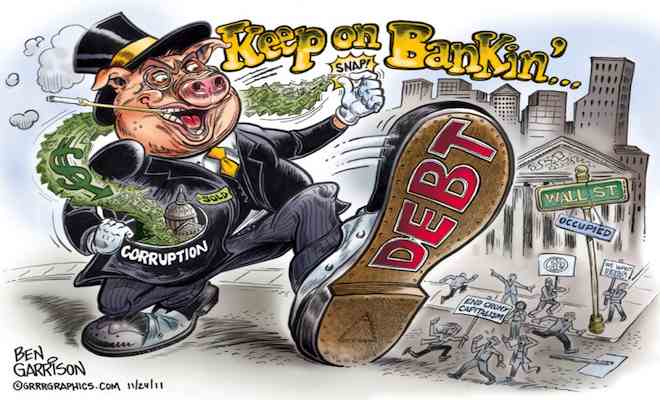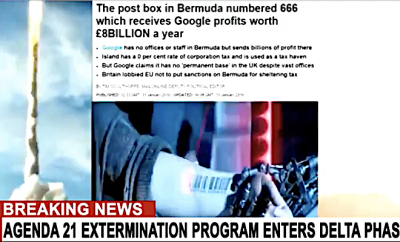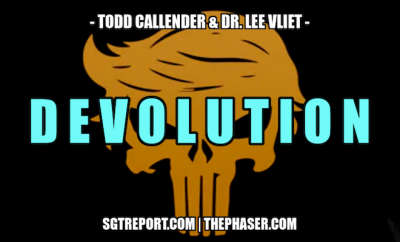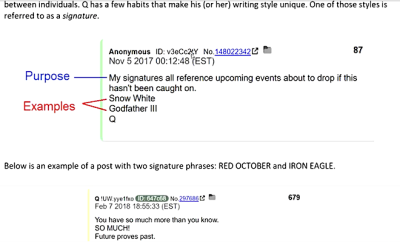 Cartoon: Ben Garrison
Cartoon: Ben Garrison
Dollar Ponzi
Swimming With Sharks: Goldman Sachs, Schools & Bonds
Goldman Sachs, School Districts & Capital Appreciation Bonds
by Ellen Brown, via Global Research:
The fliers touted new ballfields, science labs and modern classrooms. They didn’t mention the crushing debt or the investment bank that stood to make millions. — Melody Peterson, Orange County Register, February 15, 2013
Remember when Goldman Sachs – dubbed by Matt Taibbi the Vampire Squid – sold derivatives to Greece so the government could conceal its debt, then bet against that debt, driving it up? It seems that the ubiquitous investment bank has also put the squeeze on California and its school districts. Not that Goldman was alone in this; but the unscrupulous practices of the bank once called the undisputed king of the municipal bond business epitomize the culture of greed that has ensnared students and future generations in unrepayable debt.
In 2008, after collecting millions of dollars in fees to help California sell its bonds, Goldman urged its bigger clients to place investment bets against those bonds, in order to profit from a financial crisis that was sparked in the first place by irresponsible Wall Street speculation. Alarmed California officials warned that these short sales would jeopardize the state’s bond rating and drive up interest rates. But that result also served Goldman, which had sold credit default swaps on the bonds, since the price of the swaps rose along with the risk of default.
In 2009, the lenders’ lobbying group than proposed and promoted AB1388, a California bill eliminating the debt ceiling requirement on long-term debt for school districts. After it passed, bankers traveled all over the state pushing something called “capital appreciation bonds” (CABs) as a tool to vault over legal debt limits. (Think Greece again.) Also called payday loans for school districts, CABs have now been issued by more than 400 California districts, some with repayment obligations of up to 20 times the principal advanced (or 2000%).
The controversial bonds came under increased scrutiny in August 2012, following a report that San Diego County’s Poway Unified would have to pay $982 million for a $105 million CAB it issued. Goldman Sachs made $1.6 million on a single capital appreciation deal with the San Diego Unified School District.
Green Light to Exploit
In a September 2013 op-ed in SFGate.com called “School Bonds Are a Wall Street Scam,” attorney Nanci Nishimura wrote:
. . . AB1388, signed by then-Gov. Arnold Schwarzenegger in 2009, [gave] banks the green light to lure California school boards into issuing bonds to raise quick money to build schools.
Unlike conventional bonds that have to be paid off on a regular basis, the bonds approved in AB1388 relaxed regulatory safeguards and allowed them to be paid back 25 to 40 years in the future. The problem is that from the time the bonds are issued until payment is due, interest accrues and compounds at exorbitant rates, requiring a balloon payment in the millions of dollars. . . .
Wall Street exploited the school boards’ lack of business acumen and proposed the bonds as blank checks written against taxpayers’ pocketbooks. One school administrator described a Wall Street meeting to discuss the system as like “swimming with the big sharks.”
Wall Street has preyed on these school boards because of the millions of dollars in commissions. Banks, financial advisers and credit rating firms have billed California public entities almost $400 million since 2007. [State Treasurer] Lockyer described this as “part of the ‘new’ Wall Street,” which “has done this kind of thing on the private investor side for years, then the housing market and now its public entities.”
Gullible school districts agreed to these payday-like loans because they needed the facilities, the voters would not agree to higher taxes, and state educational funding was exhausted. School districts wound up sporting shiny new gymnasiums and auditoriums while they were cutting back on teachers and increasing classroom sizes. (AB1388 covers only long-term capital improvements, not daily operating expenses.) The folly of the bonds was reminiscent of those boondoggles pushed on Third World countries by the World Bank and IMF, trapping them under a mountain of debt that continued to compound decades later.
The Federal Reserve could have made virtually-interest-free loans available to local governments, as it did for banks. But the Fed (whose twelve branches are 100% owned by private banks) declined.
Read More @ Global Research.com

















